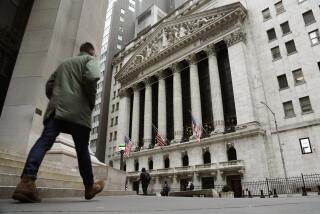Wholesale Inflation Soars, Sending Dow Reeling 48.5 : Sharpest Decline in Nearly Year
- Share via
NEW YORK — A rude inflation surprise jolted Wall Street today, driving the stock market into its sharpest decline in nearly a year.
The Dow Jones average of 30 industrials fell 49.64 to 2,291.07, for its biggest point decline since it tumbled 101.46 last April 14.
That all but wiped out strong gains recorded earlier in the week, leaving the average with a net increase of 8.93 points from the previous Friday’s close.
Declining issues outnumbered advances by almost 7 to 1 on the New York Stock Exchange, with 214 up, 1,424 down and 309 unchanged.
Big Board volume hit an eight-week high of 242.90 million shares, against 196.04 million in the previous session.
The NYSE’s composite index dropped 3.45 to 164.65.
Before the opening, the government reported that the producer price index of finished goods rose a full percentage point in February, matching its increase the month before (Story, Page 3.)
That news came as a rude shock to stock traders, who had been expecting a gain of about half that size, and set off a new wave of inflation and interest-rate worries.
In the credit markets, prices of long-term government bonds, which move in the opposite direction from interest rates, fell about $20 for each $1,000 in face value.
Fed Action Expected
Conjecture immediately began to spread in the financial world that the Federal Reserve would feel compelled to take further steps soon to tighten credit in its effort to keep inflation restrained.
Late in the session, the market was hit with another setback when International Business Machines, the No. 1 holding of investing institutions, said its first-quarter earnings would fall short of analysts’ expectations.
The intensity of activity in the stock market was heightened by the so-called “triple witching hour,” a quarterly occasion when the last trading occurs in a set of expiring options and futures on stock indexes.
This situation prompts heavy trading by professionals engaged in computer program strategies that involve both the options and futures and individual stocks.
Bond prices plunged in their steepest drop of the year and interest rates rocketed higher because of the government’s report of a stronger-than-expected rise in a key inflation measure for February.
The Treasury’s benchmark 30-year bond was down 2 points, or $20 per $1,000 face amount, at midday, and its yield, which moves in the opposite direction from price, climbed to 9.31% from 9.11% late Thursday.
The previous biggest daily drop this year in the 30-year bond price was a 1 5/8 point decline on Feb. 9.
Traders scrambled to sell bonds within moments of the Labor Department’s report that wholesale prices soared in February.
Robert Brusca, chief economist for Nikko Securities International, said the report was terrible news for the bond market because it indicated that inflation poses a problem despite the Federal Reserve’s efforts to curb it by pushing interest rates higher.
“Given what’s going on with oil prices, we can’t say we expect good news next month either. . . . There is nothing good in this report,” he said.
More to Read
Inside the business of entertainment
The Wide Shot brings you news, analysis and insights on everything from streaming wars to production — and what it all means for the future.
You may occasionally receive promotional content from the Los Angeles Times.










